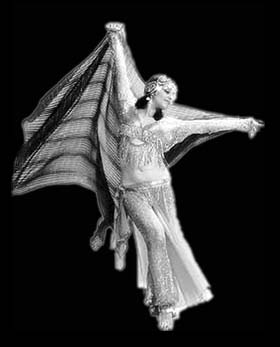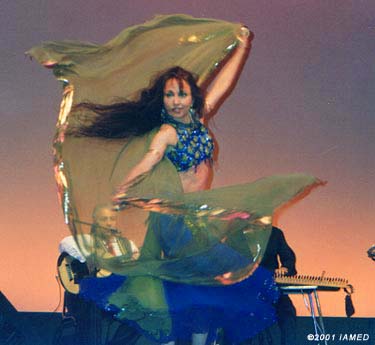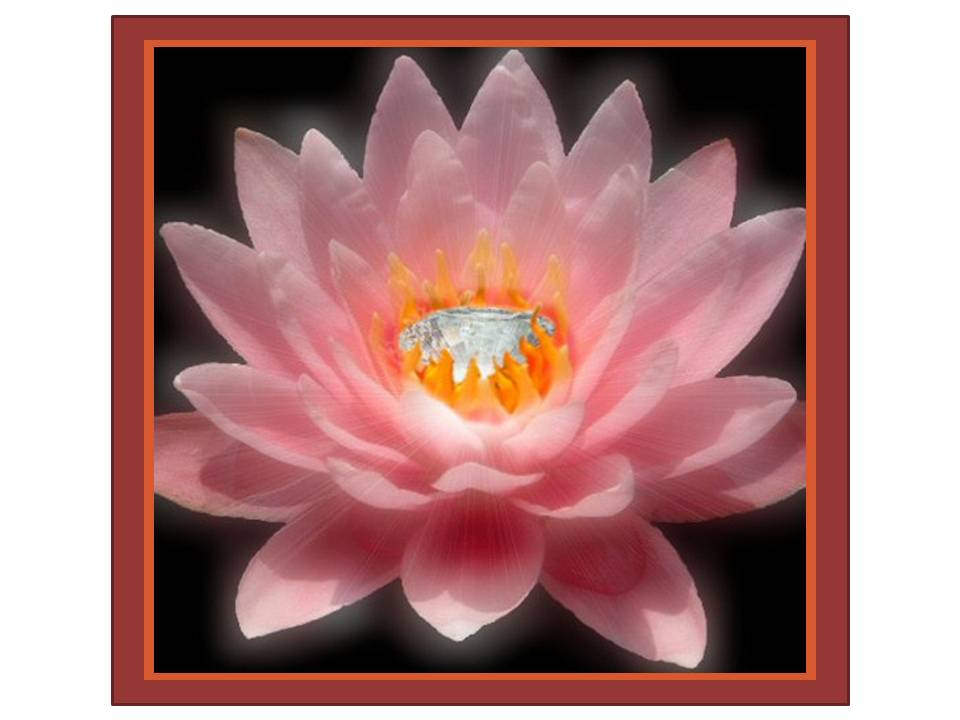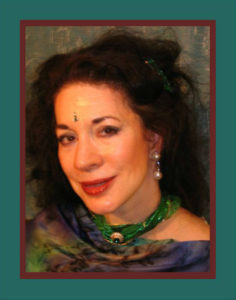Seven Tips to Making Friends with Your Veil – and Getting It to Do What You Want!
Belly dancing with a veil helps make our dance much more interesting and exciting. Veil dancing is one of the most important aspects of learning belly dance (Oriental dance). Your “dance of veils” – if done right – can enrapture your audience. Veils help make your belly dance costumes more beautiful, complete, and satisfying.

Not all belly dance lessons include veil technique. This blog post introduces tips to improve your veil dance, and give you links to some good belly dance DVD and YouTube resources. It will help you learn belly dance online with useful free resources. With some practice, you can do a “veil belly dance” that will add to your repertoire and let you be more artistically creative and emotionally expressive.
Nothing – absolutely nothing – increases our “glamour-factor” more than dancing with a good veil. It’s not just that our veils immediately give us more “presence” on stage. They also frame us (naturally, in the best color possible). They also extend our “reach” – allowing even the most petite of dancers to command the stage more readily.
Swirling, “big-scale” veil dynamics provide an exciting counterpoint to the often more delicate, understated, or precise vocabulary of undulations and pelvic techniques. For this alone, they are a valuable part of a dancer’s “expressive vocabulary.”
Veils give us an opportunity to build up the dramatic tension – the excitement, the anticipation – as we slowly unveil ourselves during certain dances. Also, they give us the most dramatic options for entrances and finales, especially when we are “circling the stage.”
In short, nothing enhances our expressiveness, our excitement, and our emotional range more than a good veil.
Some of us, though, feel that our veil is more of an enemy than a friend.
How do we “tame” our veil? How can we make it an extension of ourselves, so that we seem to naturally, gracefully, and effortlessly control the stage, command the veil, and compel our audience’s rapt attention?
This blog will present: Seven Tips to Make Your Veil Your Friend
Briefly, these are:
- Make Sure Your Veil is the Right Length and Color for You
- Make Sure Your Veil is the Right Material and Weight for Yourself
- Three-Point Control
- Learn How to “Frame Yourself” with Your Veil
- Put Enough “Oomph” Into Your Veil Moves
- Move Your Body When You Move Your Veil
- The Power of Nuance – It’s All in the Wrist!
Tip #1: Your Veil is an Important Part of Your Belly Dance Costume: Make Sure It is the Right Color and Length for You
While 2 1/2 yards was the “standard” length for years, many of us now use at least 3 yards. Over the years, I’ve moved away from shorter to progressively longer veils.
The most important length factor relates how long the veil is – when you are holding it – to how much length there is from the tips of your fingers to the floor.
My favorite veil – the one with the best length, color, weight, and “lift” – is 3 yards long. When I hold it in “basic veil” position – across my neck and shoulders, and down at each side, the each side of the veil is just 6 inches off the floor. This is a very good and workable length. I have about 18 1/2 inches of veil “trailing” from each of my fingertips. This is enough to be dramatic on stage.
Less veil (2 1/2 yards), and I lose stage drama. Too much veil, and it gets unwieldy; it’s harder to put enough “oomph” into it to keep the edges from getting fouled, and there’s increased risk of stepping on the veil.
To sum the length suggestion: About 6 inches from veil edge to floor, while you hold the veil centered on the back of your neck, is about right. For me at 5 feet, 4 inches, this means a 3-yard veil. If you are much taller – say 5′ 10″ or more – you could seriously think about a longer veil; up to 3 1/2 yards.
I’ve worked with long veils – 4 yards and more. They require more proficiency, and also more stamina. Longer veils mean more effort to keep them “floating,” so it helps to be in good shape and to have good technique before progressing to a really long veil.
Color is also important. If you haven’t had a professional color analysis done, use online resources to help you figure out your best colors. Your veil will reflect onto your face and body, so you want a color that will make you look your best.
For more on how to select your veil, you may wish to read Chapter 4: “Playtime for Grown-Up Girls,” in Unveiling: The Inner Journey.
|
Paper |
Kindle |
|||
Tip #2: Make Sure Your Belly Dance Veil is the Right Material and Weight for Yourself
Silk is infinitely preferable to any man-made fiber. Silk “floats” better, drapes better, and is more responsive. Katia teaches some wonderful moves for dancing with a silk veil in this Katia Silk Veil Dancing YouTube clip, based on her longer instructional DVD (see below). While sometimes silk chiffon can float beautifully, I prefer a heavier weight china silk – heavier than that used for linings. However, silk crepe is too heavy, and won’t give you the right “loft” in your moves.
Some dancers use rayon veils or polyester chiffon veils with lurex-stripes (mostly popular with beginning dancers). Aziza dances with a silk veil in Aziza’s veil dance YouTube clip. In this same clip, though, she also discusses rayon veils, as well as the issue of “trim” on your veil.
Some dancers prefer polyester – Petite Jamila (of Bellydance Superstars fame) works with two rather large and heavy half-circle polyester veils. But these are SO not for beginners! The simple weight of these makes for an upper-body and arms workout that would exhaust many weight-lifters.
See the link to Katia’s and Aziza’s instructional veil belly dance DVDs below; between these two, you can’t go wrong for good instructional basics, with some advanced techniques thrown in.
Two Good Veil Belly Dance DVDs
Katia and Aziza both have excellent introductory belly dance veil instructional DVDs.
|
DVD |
DVD |
|||
Tip #3: Three-Point Control to Improve Your Veil Dance
When you take up your veil, and hold it behind you, you should “connect” with your veil at three points: in each hand (one point for each), and the back of your neck. That “back of the neck” connection is what gives you control. (This tip is courtesy of Anahid Sofian, who is one of the “great masters” of veil dancing.)
Tip #4: Learn How to “Frame Yourself” During Your Veil Dancing

In the previous blog, I gave links to Two YouTube Veil Dance Resources featuring Anahid Sofian and her protégé Eva Cernik, who is now a master dance teacher and performer in her own right.
These two teachers, along with those given in this post, will give you a great sense of how to frame yourself when you hold your veil. For more hints, you can (again) read Chapter 4: “Every Woman Needs a Veil,” from Unveiling: The Inner Journey.
Tip #5: Put Enough “Oomph” Into Your “Dance of Veils”

Veil dancing can be – and should be – highly dynamic.
Evalina Papazova does some beautiful – and very dynamic and demanding – veil dancing in this YouTube clip.
Evalina’s dance is particularly interesting – she commands a large stage in a solo dance with a combination of veil spins and turns, coupled with good movement patterns across the floor. Her dance shows very well, even on a large stage – this is difficult even for experienced dancers!

Even if you’re new to veil belly dance, you can learn not only from online belly dance lessons and belly dance DVDs, but also from your own body.
From Unveiling: The Inner Journey, Chapter 4: “Playtime for Grown-Up Girls”:
“Now that you have your veil, play with it! First, find a “safe” time and a “safe” place. A safe time is when no one else is around. This time is for you … You need to get your feedback directly from yourself; from how your body feels, and what emotions you are feeling.” [p. 47, Unveiling: The Inner Journey]
Tip #6: Move Your Body When You Move Your Veil
Not many teachers include veil technique in their belly dance lessons. Even fewer teach students to use their whole bodies when they move their veils. All too often, dancers wind up using their arms alone.

Sira was featured in Anahid Sofian’s 2011 Atelier, showcasing some of NYC’s finest dancers. In this veil belly dance YouTube clip Sira’s beautiful vintage-style dance shows excellent and fluid veil work, including lots of spins and turns.
In this “vintage style” dance, I particularly like the hypnotic quality of Sira’s sustained spins; she demonstrates the important reminder that we need to stay with a technique long enough to give the audience the full impact of what we are doing – something that might seem “too long” for us will be just incredibly right for our audience!
Sira’s dance also included an equally hypnotic floorwork (taqsim) section, with exceptional hands and arms. It concluded with an exotic and exciting Za’ar (trance dance) finale; probably the best Za’ar that I’ve ever seen!

Become the Jewel!
You study and perform belly dance (Oriental dance) because it brings forth a special aspect of who you are – the full range of your emotional expressiveness; both the sensual and sacred aspects of your being.
Join me – get the latest on how to become the jewel (a fully expressive you) in the heart of the lotus (your life, and all that surrounds you)!

Aziza is another dancer who has excellent veil techniques.
Aziza has a lovely veil DVD. However, you can learn good veil belly dance techniques online simply by studying Aziza’s veil dance YouTube clip.
The DVDs given earlier in this post provide good starting belly dance veil instruction. In future posts, I’ll provide my own YouTube links so that you can learn belly dance online, especially belly dance with veil.
Tip #7: The Power of Nuance – It’s All in the Wrist!

Study Kaeshi (of Bellydance Superstars fame). In this Online Veil Belly Dance Instruction YouTube with Kaeshi, you’ll see her demonstrate some very expressive and powerful veil techniques. Although it’s difficult to see her wrist action in this YouTube clip, you’ll find that you really need to work your wrists (and your whole body) to get the same effect when you practice veil dancing at home.
Kaeshi also has a performance YouTube clip, featuring beautiful veil dancing.
For “extra credit”: Study the vintage clip of Elena Lentini. Can you see how Elena has influenced Kaeshi’s style? One of fascinating study in learning belly dance online is to trace the influence of major dancers on some of today’s most well-known and rising stars! Kaeshi has been with Bellydance Superstars, and has a strong following in her own right. However, I’ve seen her for years in New York belly dance workshops with Elena Lentini and others, and have observed how she’s integrated important aspects of their styles and made them her own.
See Petite Jamilla’s DVD for good examples; her basic veil techniques often require good wrist work to be effective, so this is a good training DVD.
|
Paper
|
||
Belly Dancing with Veil: Summary
Veil belly dancing requires more strength, stamina, fine-tuned coordination, and movement than does “regular” belly dance. However, as you develop your veil repertoire, you’ll gain confidence and exceptional stage presence, along with a much more expressive “artistic vocabulary” for your dance. This is a challenging study, but so worth the effort!

Very best wishes as you make your dances more dramatic, interesting, and exciting by including a veil!
Yours in dance –
Alay’nya
Author of Unveiling: The Inner Journey
You are the Jewel in the Heart of the Lotus. Become the Jewel!
Founder and Artistic Director, The Alay’nya Studio
Bellydance a courtesan would envy!
Check out Alay’nya’s YouTube Channel
Connect with Alay’nya on Facebook
Follow Unveiling: The Inner Journey on Facebook
From Morocco’s Amazon review of “Unveiling: The Inner Journey”: “Unveiling – the Inner Journey” by Alay’nya (Alianna J. Maren, PhD.) is an important book that I wish had been written much sooner. It’s not just for dancers, but a book that mothers and aunts should give to the young women in their families before they go forth to forge their own lives and one I recommend others read to determine how close they are to “getting it.”
|
Paper |
||
Copyright (c) 2013, Alay’nya. All rights reserved.





